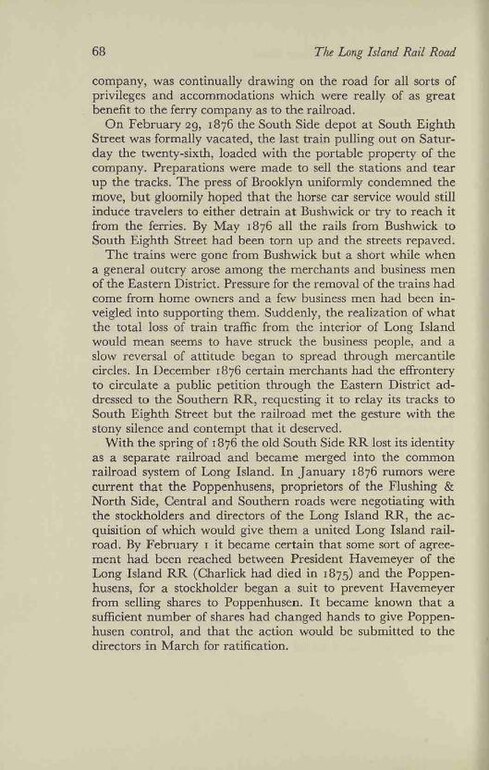company, was continually drawing on the road for all sorts of privileges and accommodations which were really of as great benefit to the ferry company as to the railroad.
On February 29, 1876 the South Side depot at South Eighth Street was formally vacated, the last train pulling out on Saturday the twenty-sixth, loaded with the portable property of the company. Preparations were made to sell the stations and tear up the tracks. The press of Brooklyn uniformly condemned the move, but gloomily hoped that the horse car service would still induce travelers to either detrain at Bushwick or try to reach it from the ferries. By May 1876 all the rails from Bushwick to South Eighth Street had been torn up and the streets repaved.
The trains were gone from Bushwick but a short while when a general outcry arose among the merchants and business men of the Eastern District. Pressure for the removal of the trains had come from home owners and a few business men had been inveigled into supporting them. Suddenly, the realization of what the total loss of train traffic from the interior of Long Island would mean seems to have struck the business people, and a slow reversal of attitude began to spread through mercantile circles. In December 1876 certain merchants had the effrontery to circulate a public petition through the Eastern District addressed to the Southern RR, requesting it to relay its tracks to South Eighth Street but the railroad met the gesture with the stony silence and contempt that it deserved.
With the spring of 1876 the old South Side RR lost its identity as a separate railroad and became merged into the common railroad system of Long Island. In January 1876 rumors were current that the Poppenhusens, proprietors of the Flushing & North Side, Central and Southern roads were negotiating with the stockholders and directors of the Long Island RR, the acquisition of which would give them a united Long Island railroad. By February 1 it became certain that some sort of agreement had been reached between President Havemeyer of the Long Island RR (Charlick had died in 1875) and the Poppenhusens, for a stockholder began a suit to prevent Havemeyer from selling shares to Poppenhusen. It became known that a sufficient number of shares had changed hands to give Poppenhusen control, and that the action would be submitted to the directors in March for ratification.
